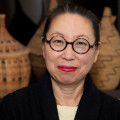The conversations changed as students embarked on their own photo projects in New York based ethnic enclaves. Students photographed all around the five boroughs – from Ghanaian hair salons in the Bronx to Taiwanese restaurants in Queens to the art studio of “the Picasso of Mauritania.”
Selected images student projects are below, and more are on our class website here.
Images [can] become catalysts for social change, can influence foreign policy, and educate a public by providing visual access to cultures and surroundings that are not accessible to everyone.
-Toni Akindele
Accepting small acts of kindness form people I barely knew only strengthened my relationship with them and enhanced the trust they put in me and the quality of the photos I took of them.
-Krystle Goodwin
I would argue that a “good” photojournalist is… one that lets photos provoke change.
-Gladys Ekoto
The danger in photos…is that they may simply reiterate harmful stereotypes. Even when the stereotypes are not immediately negative, media portrayals of the developing world continually assert the difference between “us and them.”
-Kirsten Stevenson




